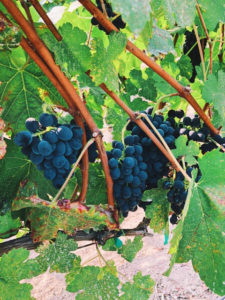The Indian Story of Wine

The Greek Connection: Magasthenes an ambassodor to Indian Court (Pliny) recorded that Dionysus in his expedition against the Indians, disguised the arms with which he equipped his troops and made them wear soft raiment and fawn skins. The spears were wrapped round with ivy and thyrus had a sharp point. He gave the signal for battle by cymbals and drums, instead of trumpets, and by regaling the enemey with wine, diverted their thoughts from war to dancing. These, and other Bacchic orgies were employed in the system of warfare, by which he subjected India and all the rest of the world (Makes a good story!)
To-date, the love-hate relationship with wine continues. Approximately 25 million liters of wine produced in India. Vineyards span approximately 6000 acres mainly across 3 different states in the subtropical low altitude hilly areas. It is about 1 percent of global wine production.
Modern viticulture was believed to have been introduced to India by Persian traders in the 4th millennium BC. In the 16th Century Portuguese colonists introduced port-style wine. In the 19th Century the British set up vineyards. In the 1890s Indian vineyards were totally destroyed, possibly by the pest Phylloxera. In the 1950s several Indian states imposed prohibition for political and religious reasons forcing the vineyards to convert to table grape and raisin production. After a long pause in the 1980s the startup of Chateau Indage winery brought v.vinifera varieties such as Cabernet Sauvignon, Chardonnay, Pinot Noir and Ugni Blanc along with European technologies and consulting French vintners and made still and sparkling wines.
Currently, Wine production in India is concentrated in the states of Maharashtra (90 percent) and Karnataka (7 percent), while the states Goa and Himachal Pradesh represent less than 3 percent of output combined. Most wineries and production are concentrated in the Nashik region in Maharashtra, which is considered the home of the country’s wine sector. Other significant wine regions include Sangli (Maharashtra), Nandi Hills (Karnataka) and Bangalore (Karnataka). The country’s diverse mix of climates allow it to grow an array of grape varieties for wine including indigenous varieties such as Anabeshahi, Arkavati and Arkashyam in addition to imported varieties such as Syrah, Cabernet Sauvignon, Merlot, Chardonnay, Sauvignon Blanc, Zinfandel, Shiraz, Chenin Blanc, and Clairette Blanche.
Sula Vineyards, Indage, and Grover Vineyards among the top Indian vineyards and wineries. Collectively, they have 90 percent of the current market.
The ICAR-National Research Centre for Grapes under Indian Council of Agricultural Research (ICAR), New Delhi was established on 18th January 1997 at Manjri, Pune. National and Regional Wine Boards have been estabilished to promote viticulture, wine-making, and regulate wine business.
In the coming years, production and consumption of wine is expected to grow with the government support and the expanding upper middle class population. Fast growing tourism industry is taking people places where they can wine and dine and experiment with food and wine pairing.
Reference:
National Research Center for Grapes India
Wine in Ancient India by Dhirendra Krishna Bose, B. A. 1922. Published by K. M. Conner & Co., Ld. Loudon Library & Press. 130, Bowbazar St. Calcutta.
Further Reading:
A short history of India’s drinking culture [Book extract] From the Vedic period to the time of the Persian invaders… By Magandeep Singh, a sommelier in India